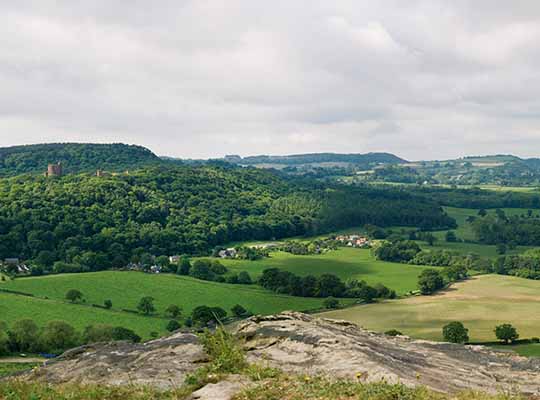Significance of Beeston Castle
For different reasons, people have been drawn to the crag for over two millennia. Although what remains on site today chiefly represents the achievement of medieval builders, much of what is important about Beeston is less tangible.

Prehistoric Beeston
Archaeological evidence indicates that Beeston was an important centre in the prehistoric landscape for long-distance trade and communication, and also a defended place protecting the production of metalwork and agricultural surplus. Excavated finds suggest that it was a major metalworking site during the later Bronze Age.
Although only a relatively small area of the site has been excavated, the scale of the late Iron Age defences suggests a much larger enclosure. It therefore seems likely that the hillfort extended over the entire area later occupied by the medieval castle. If so, Beeston would have been the largest hillfort constructed in what later became Cheshire.
Medieval Castle Design
Beeston is an outstanding example of castle building as a visual embodiment of lordship. The location and form of the 13th-century castle were a dramatic display of authority by its builder, Ranulf, Earl of Chester, at a time of power struggles within the English royal court.The defences built in the 1220s by Ranulf also belong to a period when the design of gatehouses became more complex, and the defences and domestic buildings began to be located in the outer ward.
The design of the gatehouse has close affinities with that built by Ranulf’s powerful Welsh neighbour, Llywelyn the Great, Prince of Gwynedd (c 1173–1240), at Criccieth (Gwynedd) and with Castle Roche, near Dundalk (Ireland), and so is part of a group of structures attesting to changing trends in castle design.
Although it is difficult to prove, it has always been thought likely that the castle owes part of its design to Ranulf’s experiences on crusade; the rock-cut ditch in particular is similar to features of buildings in the Holy Land.
Border Castles
Beeston also stands as an example of how castles on the English border with Wales should not automatically be interpreted as fortresses connected with frontier defence. The castle stands to the east of Chester, rather than in the west of the county, which was more vulnerable to Welsh incursions.
Furthermore, before Ranulf left for crusade in 1218 he had entered into a truce with Llywelyn the Great. This alliance continued on Ranulf’s return in 1220 and meant that at the time of the castle’s construction the northern part of the English border was secure.
Any threat to Ranulf’s position that led him to construct Beeston Castle came not from marauding Welshmen, but from power struggles within the English court.
The Castle in its Landscape
It is probably significant that one of the first documentary references to the castle concerned the use of eyries (eagles’ nests) for the king, which suggests that the surrounding area was used as a hunting ground. There was certainly a deer park at neighbouring Peckforton.
It is also possible that the castle provided the inspiration for the fictional castle of Sir Bertilak in the late 14th-century Middle English poem Sir Gawain and the Green Knight. If so, this further underlines the importance of Beeston in the medieval period.
The Civil War
The reuse of the ruined castle during the Civil War shows how a medieval fortress could still have military value centuries after its initial construction.
The excavated finds from the castle dating to this time represent a period of protracted siege warfare.
The Picturesque
The trend for building ‘follies’, or incorporating ruined buildings into gardens and parkland, is a well-known aspect of landscape design in the 18th and 19th centuries. Beeston is one of the most dramatic examples of its kind.
The juxtaposition of a major 13th-century fortress with a 19th-century mock castle is unique in England.